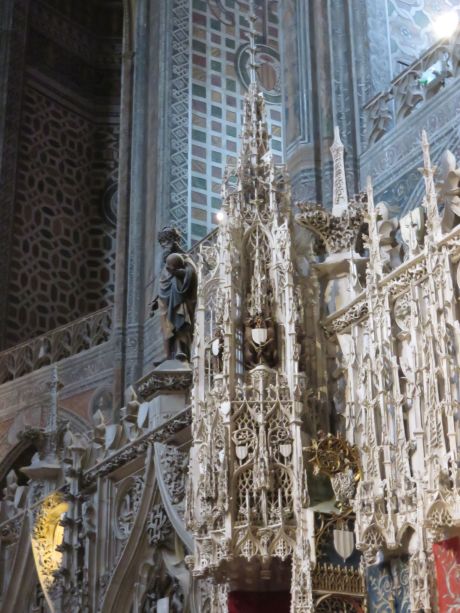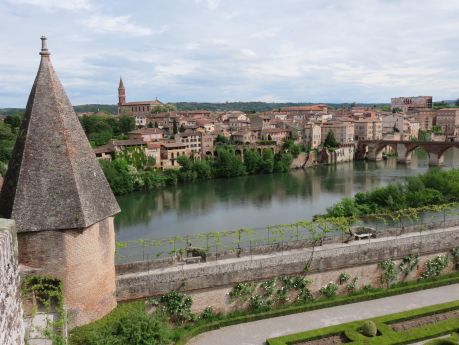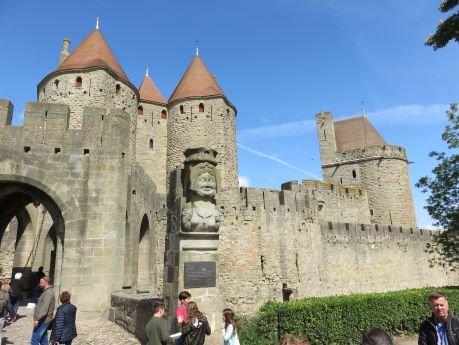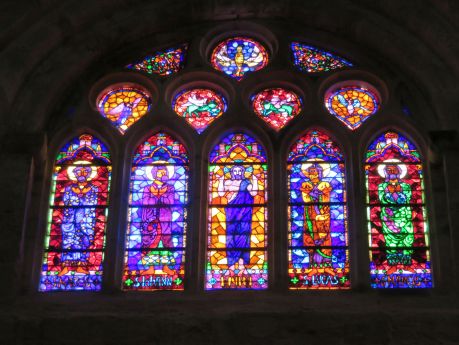Part 1: SOUTHERN FRENCH CONNECTION: ART, FOOD and WINE
Art. Food. Wine.
Those were the three words that drew my husband, Russ, and I to book our two-week tour to Southern France, the Languedoc and Provence regions. Russ expected this tour would be a bit more laid back than our previous Odysseys Unlimited tours, though sometimes we still felt as if we were racing against time to cram in as many cultural experiences as we could before our weary bodies collapsed. That’s not a complaint, by the way… just the reality of not wanting to miss out on anything we’d later regret not having seen, tasted, or drunk.
Southern France triggered an emotional reaction for me. I lived in France as a child for three years when the Air Force sent my dad there, first to Bordeaux and later to Chateauroux (where my brother was born). I remember living on a farm before military housing was available. I recall watching people stomp on grapes in vats behind our house and knew that the French in those days (and no, I am not revealing the exact years) were conflicted about whether to love or hate Americans, so becoming fluent was essential to blending in. The detritus of memories of farmers, vineyards, gypsies in carts on dirt roads (albeit the ones who once tried to kidnap my strawberry-blonde, fair-skinned sister), puffy fried dough at a local carnival, or the crunch of a fresh baked baguette still fondly inhabits my heart.
I wanted “that France.” I wanted to reconnect with the sensory impressions I still bear of French villages and a people who know how to celebrate joie de vie more simply than the glamour and bustle of Paris (even though Paris remains one of my favorite destinations in the world).
How did this trip turn out? The pace was less frenetic than sometimes occurs with a tour. We absolutely cherished our still-limited time in the villages and towns we visited, such as Carcassonne, Collioure, St-Remy-de-Provence, and Les-Baux-de-Provence, but also found the beauty in cities such as Arles, Avignon and Aix-en-Provence.
During our two weeks, we saw the impact artists such as Paul Cézanne, Pablo Picasso, Vincent Van Gogh, Paul Gauguin, Salvador Dali, and Henri deToulouse-Lautrec had on the people and places where they lived and/or painted, and how those very places and some of the friendships the artists shared with one another were the impetus for their inspirations.
Most of all, we savored the cuisine, drank local wines, and were refreshed by the colorful landscapes of bright flowers, medieval castles jutting over green fields, and the artistic display of herbs, olives, and nougat at farmer markets.
Our journey began when we arrived in Toulouse and were whisked away by private car to Albi, where our first of four hotels was located. Staying in a central location and taking day excursions is quite common on group tours.
ALBI, CARCASSONNE and NARBONNE
ALBI
Where we stayed:
Hotel Saint Antoine – One of the reasons we enjoy travelling with Odysseys Unlimited is that the maximum 24-person group allows us to stay in boutique hotels, most of which turn on air conditioning in May and many of which are centrally located to restaurants, shops and attractions. Such was the case with Hotel Saint Antoine, a fifth-generation, family owned 44-room hotel just steps away from the UNESCO World Heritage-listed Sainte Cécile Cathedral and the Toulouse-Lautrec museum. As rooms are individually decorated, Russ was elated ours featured ducks, a favorite fowl of his. The room had embossed yellow-patterned wallpaper, stylized sconces, duck-themed duvet, and carved wooden ducks propped on furniture. Wide oak slatted flooring, a small patio overlooking the manicured gardens, and a walk-in shower completed the look. There were no washcloths nor a place in the shower to put personal soap or bath scrub.
What we saw:
To appreciate the art, artists and architecture of Southern France, we likely could not have had a more knowledgeable Tour Director than Fanny Poirier. Born in Avignon and with an extensive background in art history, she never faltered when asked questions about the dates buildings were erected, in what style, or insider details about the painters who immortalized the region.
We visited the 13th century Sainte Cécile Cathedral, one of the world’s largest brick structures and a significant physical reminder of the Catholic Church’s dominance over a region formerly ruled by Cathars, termed heretics in the aftermath of the Albigensian Crusade. Built high on the hill above the River Tarn during the 13th and 14th centuries, the imposing cathedral was originally constructed as a fortress to repel invaders. The Church hasn’t been restored as much as it has been preserved. It’s plain outside and ornate inside. There are three distinguishing characteristics that set it apart from other churches of the time. A Northern Gothic style framework was added to the main entrance in the 15th and 16th centuries. A carved white stone (not wood as was typical of the time) rood screen of intricate lacework separates the choir from the open access nave. Third, the high vaulted ceiling bears the oldest representation of the Last Judgement, allegedly painted in the 15th century by unknown Flemish painters.
Walking along the sidewalk paralleling the River Tarn and acting as a barrier to the uneven terrain below, I was fascinated by a plethora of trees laden with white pine cone-shaped flowers. These horse chestnut (or conker) trees are quite common in Southern Europe, but new to me. Apparently, when the leaves fall off, they leave horseshoe shaped scars on the twigs.
While on our tour, Fanny pointed out a majestic structure called Hôtel Reynès, a renaissance styled mansion built in 1530 by the Reynès family for hosting their many party guests. I was struck by the massive doors guarding the entrance courtyard. When the doors were shut, they virtually eliminated both street noise and nosy passersby from the house guests. Albi is one of the main cities in Southern France built from Languedoc (red limestone) brick, so it’s no surprise that the fabulous decorative façade of Hôtel Reynès would be composed of a combination of stone and bricks.
One of the largest Romanesque churches in Albi is Saint Salvi, an 1100s church named for Saint Salvi, who became the first bishop of the city in the 6th century. The impressive bell and watch tower was actually the “proof” of one’s wealth. Rich people couldn’t boast about their wealth, but building a taller tower than someone else settled the competition.
We were passing Saint Salvi church on May 8, and a group of flag-bearing World War II vets and family members lined the entrance as those paying tribute to Armistice Day were leaving the service. The city’s Mayor and some of her entourage approached our group, inquired of Fanny who we were, and then said to tell us that they honor the support Americans gave them in the war and were happy to welcome us to their city. All 18 members of our Southern France tour group soaked in the thanks, appreciating what America’s support meant to their freedom.
Of course I know Toulouse-Lautrec (1864-1901) from his paintings of dance hall women and brothel scenarios, or even the photo of him standing in a long black coat, bowler hat, dark mustache and beard, with spectacles riding the bridge of his nose, but it was likely watching Moulon Rouge-themed movies that I learned of the sadness wrought by crippling leg injuries at 14 that never healed. His physical deformities motivated him to turn to prostitutes and dance hall women for companionship. They then became his muses. In 1905, France passed a law separating church and state, which became the impetus to erect a state-owned fine arts museum, now named the Musee de Toulouse-Lautrec. The former Palais de la Berbie today features 800 pieces of his art, much of which was donated by his family. The museum exhibits show how one of the best known post-impressionists of his time progressed from his first paintings at age 15 to print, creating the iconic posters showcasing his days spent in Montmartre and brothels.
What we learned:
French merchants made a lot of money from selling pasto, a yellow flower used for dying. Albi once enjoyed prosperity from producing and selling that and another local plant, bleu du Cocagne, a beautiful blue pastel color.
France is still mostly agricultural, but they don’t grow mustard seed. The seeds are imported from Canada to Dijon to make mustard.
Three kinds of asparagus are grown in France: green, white and purple. This is a large export and most every restaurant serves it.
Paris is the largest city with about two million. Marseilles is second, with about one million.
Prefectures are what we might term City Hall. There are roughly 100 of them in the main counties. A prefecture belongs to the Ministry of the Interior, acts administratively, and is therefore in charge of the delivery of identity cards, driving licenses, passports etc.
Occitan language (also called Provençal or Languedoc) is a Romance language spoken by about 1,500,000 people. Occitan speakers use French as their official and cultural language, but dialects are used for everyday purposes. This is very similar to Catalan in Spain, which schoolchildren learn as their first language.
Shops are typically open 10-7 pm. In smaller towns, stores usually are closed from noon to two for lunch.
Master artisans in France are called companions. The country has many capable of repairing and redesigning structures. Those skills will be necessary to rebuild Notre Dame from the mid-April fire.
I’ve discovered that nearly every woman in our tours belongs to a book club. Often books they’ve read are relevant to places we’re visiting. On this trip, one of the women recommended Labyrinth, an archaeological mystery published in 2005 by Kate Mosse. The intertwining storyline is set in both present-day France and the Middle Ages. The novel reflects on the massacre at Béziers and the Crusade against the Cathars in Occitania in about 1200, in the vicinities we were then visiting.
As the last countries Russ and I travelled to (Scandinavia and Eastern Europe) emphasized teaching English in schools, it’s a bit of a surprise how many local French people speak little or no English. Fortunately, although my French is rusty, it’s enough for me to communicate and read. Fanny says many Southern French people are concerned about their broken English, but if greeted with a friendly Bonjour (good day) or Bonsoir (good evening) before asking any questions or seeking assistance, there will be less awkwardness.
Lavender fields bloom from mid-June to July, so unfortunately, we were not blessed with the profusion of violet color rising from the fields.
Where we ate and drank:
Our group’s welcome-to-France dinner was at L’Epicurean. We drank a locally-produced white wine (Mauzac from Damien Bonnet 2017), with tangible apple notes, followed by a red Chateau de Mayragues from Gaillac, produced by Famille Geddes, a Scottish family who combined braucol and cabernet sauvignon. Braucol is a hardy grape variety from the Gaillac wine-growing region, with strong flavors of blackcurrant and raspberry. The wine was earthy but light, complementing the sliced veal, mashed potatoes, and cut snippets of roasted asparagus. Waiters wore very stylish brown leather aprons. Dessert was a meringue puff over mascarpone and accented with strawberry sorbet. The meal was a wonderful taste of what to come on this trip.
Our second group dinner was in a cozy, family-owned restaurant called La Viguiere D’Alby. We began with a shot of kir infused with violet flower. The area is as well-known for violet flowers intermingled into soaps, lotions and most any food, just as you’d find lavender in other areas of Southern France. The kir was accompanied by an amuse bouche of veloute of asparagus with bacon. I could have made a meal of that it was so yummy. Russ and I both chose the goat cheese salad for the appetizer, and puzzled at the unnecessary prosciutto sprinkled throughout. (Something I learned about food on this trip: not all dish descriptions include elements that may trigger allergies or counter lifestyle choices. Case in point was the proscuitto.) Russ then had the roasted guinea fowl with mustard sauce. Though he enjoyed the unexpected Middle Eastern spices, he did find the fowl difficult to cut away from the bone. My Tarbais Bean Cassoulet with duck confit and hefty portions of cured sausage with garlic, Toulouse sausage and smoked bacon didn’t have as much broth as I expected, but there’s no denying the superb taste. Russ and I traded off bites of our respective desserts. His chocolate lava cake was piping hot and my apple tart inside a crispy puffed pastry shell with caramel coulis was divine. Both came with vanilla ice cream.
The Tourism Office describes Pizzeria del Duomo as a slice of Italy. Can’t say we agreed. Russ’ pizza sauce tasted like it came straight from a can, but the cheeses mostly masked the sauce. My chef’s salad was the better choice. Interestingly, on this trip, we noticed that arugula often substitutes for lettuce when the menu descriptions just say greens. The salad was crisp, but the real flavors were in the herbed pizza bread, roasted eggplant, fresh buffalo mozzarella and a drizzle of sweet balsamic that came with it. Two points for its location overlooking Sainte Cécile Cathedral.
CARCASSONNE
The Romans weren’t the first people to live in Carcassonne, but they were the ones in the first century to build an imposing fortified city high atop the hill, with views from its ramparts and battlements stretching to the Pyrenees. Before even entering the city’s massive gated doors, one can’t help but notice the prominent sculpted stone head of Madam Carcassonne either welcoming you in, or daring you to come in at your own risk. Leader of the Moors, Madam Carcassonne’s successful efforts to thwart an invasion by Charlemagne is the stuff of which legends are made and embellished. Allegedly, she and her followers fattened up their last pig with the remnants of grain and tossed it from the towers at the soldiers. The pig burst and the undigested food and guts spilled out. The invading soldiers hastily departed.
You don’t need much imagination to realize how this UNESCO World Heritage site could defend itself from behind the solid rock walls. Thanks to a 19th century restoration project led by architect Eugene-Emmanuel Viollet-le-Duc, the crumbling city has been restored and preserved. Legend has it that the citadel’s 53 towers inspired the Walt Disney classic, Sleeping Beauty. Two of the towers are round, making it more difficult for invading forces to have scaled to the top by resting their ladders against them.
NARBONNE
The Abbaye de Fontfroid is not the first monastic complex Russ and I have been to on our tours, but it is the first that was brought into the 20th century by private owners. I knew something was different as soon as we passed oversized herb boxes lining the path to the Abbaye. The herbs aren’t just for decoration. They are actually used for medicines and for the wines that are still a successful enterprise. The Abbaye de Fontfroid is regarded as one of the best preserved Cistercian monuments in France. The Cistercians lived a communal life, pledging obedience, fidelity, silence, poverty and chastity. Not permitted to leave the Abbaye, the monks developed relationships with lay people who lived in separate quarters but could work outside the complex doing the work the brothers couldn’t. However, the brothers were quite self-sufficient, building the Abbaye from local materials such as sandstone and wood.
FonteFroide means “cold spring” and from which their water came. By the 18th century, the remaining dozen or so monks had become rich from winemaking. In the process, they overlooked their Benedictine vows and chose to live a life of luxury. The last of the Benedictine monks fled to Spain in 1901 when monastic communities were legally abolished.
Two years later, French artist Gustave Fayet and his wife Madeleine, avid art collectors, purchased the Abbaye, intent on restoring and improving both the buildings and the gardens. Among their guests and friends were Paul Gauguin, who frequently worked on his paintings there, and Richard Burgsthal. After World War 1, Burgsthal collected the shattered remnants of church windows in northern and eastern France destroyed during bombings. He then fabricated 34 stained glass mosaicked windows, which are gloriously colorful, especially when the light pours through as it did during our visit. In 1990, a rose garden was planted on top of the old cemetery of the monks. Today it’s one of the largest rose gardens in the south of France, with about 2,500 roses in 16 varieties. The maintenance of the Abbaye de Fontfroid is overseen by two families of Fayets who live within the property’s parameters year round.
In Part 2, we, we explore the mid-century architecture of Perpignan, the City of Painters that is Collioure, and the surrealism of Salvador Dali’s mind and museum in Figueres, Spain.
Karen Kuzsel is a writer-editor based in the Orlando area who specializes in the hospitality, entertainment, meetings & events industries. She is an active member of ILEA and MPI and is now serving on the 2019 – 2020 MPI Global Advisory Board for The Meeting Professional Magazine for the fourth consecutive year. She is a member of the Society of Professional Journalists. Karen writes about food & wine, spas, destinations, venues, meetings & events. A career journalist, she has owned magazines, written for newspapers, trade publications, radio and TV. As her alter-ego, Natasha, The Psychic Lady, she is a featured entertainer for corporate and social events. karenkuzsel@earthlink.net; www.ThePsychicLady.com; @karenkuzsel; @thepsychiclady. Food photos for this series by Karen Kuzsel.
All other Photos by Russ Wagner, a retired government planner/builder who has a passion for trains, travel and taking photographs.
www.hotel-saint-antoine-albi.com/en
www.albi-tourisme.fr/en/saint-cecilias-cathedral
https://en.wikipedia.org/wiki/Saint-Salvi-de-Carcavès
www.musee-toulouse-lautrec.com/en
www.restaurant-viguiere-alby-tarn81.fr/
www.albi-tourisme.fr/en/pizzeria-del-duomo
In Part 2, we, we explore the mid-century architecture of Perpignan, the City of Painters that is Collioure, and the surrealism of Salvador Dali’s mind and museum in Figueres, Spain.




















Karen – what a wonderful and educational read! So detailed, and since it’s one region of France that I’ve not yet had the chance to explore, I’m learning and making mental notes ‘for that day’ when my opportunity comes. Meanwhile, I’ll enjoy taking the journey with you and your great posts. Merci, Madame!
Am happy to hear I may have sparked some travel plans and itineraries. If you liked Part 1, hope you’ll also enjoy 2 -5. As soon as this blog series is finished, I begin on Switzerland, Austria, Germany etc, the trip that followed.Blessings to you and your family. Keep traveling.